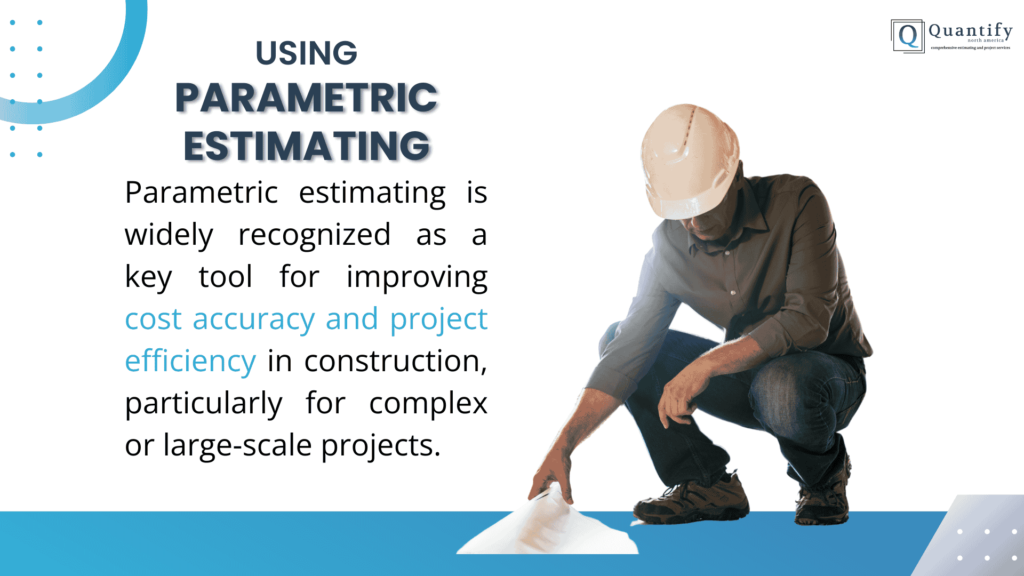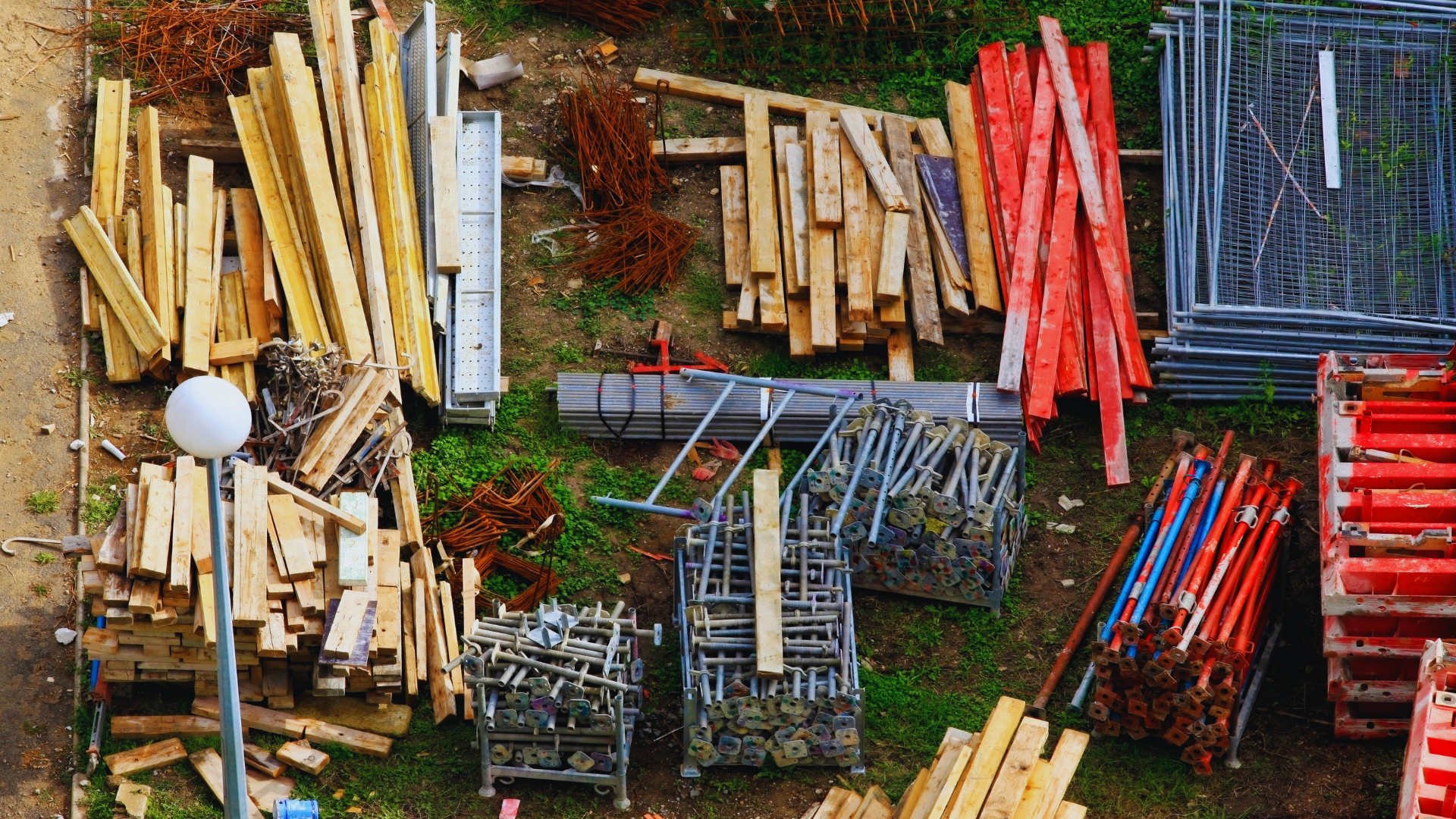Estimating project costs correctly is crucial for successful construction planning. It isn’t something you can afford to get wrong. Bad estimates hurt profit margins, damage client relationships, and can completely derail projects.
Mid and large-sized contractors know this challenge all too well, especially in today’s unpredictable material and labor markets where finding consistent, reliable estimation methods is essential.
Parametric estimating has become a go-to technique for experienced estimators. It is known to serve contractors as a reliable, data-driven approach to creating accurate predictions. This guide looks into the mathematical estimating technique, what it entails, its pros and cons, and how it stacks up against other methods of estimating.
What Is Parametric Estimating?
Parametric estimating is a project estimation method that applies a mathematical analysis to cost estimating. It uses data from past projects and takes it under statistical analysis to generate costs, timelines, or resources required.
The technique majorly focuses on identifying and combining factors that will affect the end result. However, in the broad sense, the basic formula looks like this:
Total Estimated Cost = Cost Per Unit × Number of Units
This formula might seem basic, but the real strength of parametric estimating comes from how you define these units and relationships. Common parameters include:
- Square footage costs for various construction types
- Labor hours needed per linear foot of conduit installation
- Material quantities required per cubic yard of concrete
- Equipment costs per hour of operation
The name “parametric” comes from these measurable factors that consistently drive project costs across similar jobs. With solid cost relationships established, estimators can quickly create accurate projections even when project scopes vary significantly.
The Mathematical Foundation
Parametric estimating stands apart from rougher approximation methods because of its mathematical backbone. A simple parametric model might just use multiplication, but more advanced implementations often include:
- Regression analysis to find the most significant cost drivers
- Statistical confidence intervals that show how reliable the estimate is
- Scaling factors that adjust for differences in project size
- Location factors that account for regional cost variations
- Complexity adjustments based on specific project challenges
Mathematics is the foundation on which parametric estimating comes from. The precise technique of calculation depends on factors such as the type of job, your experience, and the complexity of the parts involved.
Parametric vs. Analogous Estimating: A Brief Comparison
Construction professionals frequently need to choose between parametric estimating and analogous estimating. Both methods use historical data, but they work quite differently.
Analogous estimating works primarily through direct comparisons to previous similar projects and relies on expert judgment. It needs minimal historical data and can be implemented quickly but typically isn’t as precise. Parametric estimating takes a more mathematical route using statistical relationships from multiple projects. It provides better scaling capabilities and more accurate results when good data exists, though it takes more time to develop initially.
There are several other factors to consider in the analogous vs parametric estimating argument, from time to use to reliability. So, a good understanding of both methods is advised as a contractor.
Benefits of Parametric Estimating in Construction
Construction companies struggling with estimator shortages or looking to improve bid accuracy find several major advantages with parametric estimating. Here are the most praised benefits
1. Better Accuracy
Parametric models built on solid historical data consistently produce more accurate estimates than other techniques. The statistical relationships capture complex interactions between project parameters that simpler methods often miss.
Customers of our comprehensive estimating service see a very significant estimation variance shrink, taking them to as low as 0 to ±10% after implementing parametric models for retail renovation projects. This shrink translates to hundreds of thousands of dollars in recovered profit margin.
2. Easy Scaling for Different Project Sizes
Once you’ve established parametric relationships, they scale remarkably well. This makes the technique incredibly valuable for contractors who handle similar project types at different scales such as healthcare renovations ranging from small clinics to major hospital wings.
3. Time Saving
While setting up parametric systems takes some initial work, mature models dramatically cut down estimation time. Many contractors report 60-70% reductions in hours spent developing estimates after implementing parametric approaches, allowing their limited estimating resources to handle more bids.
4. Data-Backed Estimates
In competitive bidding situations, being able to explain your numbers makes a big difference. Parametric estimates built on statistical analysis provide clear, defensible figures that build client confidence and strengthen your negotiating position.
5. Consistent Results Across Multiple Estimators
For firms with several estimators or those using part-time estimation support, parametric approaches ensure consistency in methodology. This reduces the variability that typically happens when different team members tackle estimation with varying techniques.

When to Use Parametric Estimating
Parametric estimating works exceptionally well in certain situations but isn’t always the right choice. Here’s where this approach typically delivers the best results:
Ideal Applications
- Recurring Project Types: Retail build-outs, multifamily housing, or office tenant improvements with consistent characteristics but different sizes
- Early-Stage Estimation: When you don’t yet have detailed designs but know key parameters
- Portfolio Bidding: When you need to estimate multiple similar projects at once
- Long-Term Planning: For capital budget forecasts across multiple years
Less Suitable Scenarios:
- One-of-a-Kind Projects: Custom, unique construction with few historical parallels
- Limited Historical Data: When your company lacks sufficient comparable project histories
- Highly Complex Projects: Those with many interdependent, variable systems may need more nuanced approaches
Knowing when parametric estimating makes sense helps contractors decide whether to invest in developing these models or stick with simpler estimation techniques.
How to Create A Parametric Estimating System
Setting up a parametric estimating approach requires careful planning and execution. Here’s a practical roadmap for construction firms looking to implement this technique:
Step 1: Gather Historical Project Data
Start by collecting comprehensive data from past projects, including:
- Final project costs broken down into major categories
- Key project parameters (square footage, room counts, etc.)
- Project complexity factors
- Regional considerations
- Market conditions during construction
Try to gather data from as many similar past projects as possible. The more data there is, the more statistically meaningful relationships can be established.
Step 2: Identify Key Parameters
Analyze your historical data to find the parameters that most consistently influence project costs. Common parameters include:
- Gross floor area
- Building height or number of stories
- Foundation type
- Exterior envelope specifications
- MEP system complexity
- Interior finish level
- Site complexity factors
Focus on parameters that strongly correlate with final costs and can be readily identified early in new projects.
Step 3: Develop Cost Relationships
Using statistical analysis (or working with estimation specialists), establish mathematical relationships between your parameters and project costs. This process might include:
- Calculating average costs per unit ($/square foot, etc.)
- Creating regression models for more complex relationships
- Developing adjustment factors for various conditions
- Establishing confidence intervals for your predictions
Tools like Excel or specialized estimation software help manage this analytical process.
Step 4: Create User-Friendly Tools
Once you’ve established these relationships, develop practical tools for your estimating team:
- Spreadsheet templates with built-in formulas
- Estimation checklists to ensure parameter consistency
- Documentation explaining methodology and limitations
- Adjustment guidelines for special circumstances
The goal is to create usable systems that maintain mathematical rigor while remaining accessible to your team.
Step 5: Validate and Refine
Before full implementation, test your parametric models against:
- Recent completed projects not included in your initial data set
- Current projects with known costs
- Independent estimates developed through other methodologies
Plan to refine your parameters based on these validation exercises, gradually improving accuracy.
The Cost of an Estimate
Creating accurate estimates requires investment in both time and resources. Parametric approaches typically need more upfront work than simpler methods, but they deliver significant long-term value through improved accuracy, faster estimation processes, and better project outcomes.
Construction firms should evaluate this trade-off carefully, weighing the initial setup costs against potential gains in efficiency and accuracy. If resources beyond money are issues, you can always hire us for estimating and project services on your painting, drywall, and flooring projects.
The resources needed for parametric estimation systems should be viewed as a strategic investment rather than an overhead. When properly implemented, these systems quickly pay for themselves through faster estimation, higher bid-win rates, and reduced project risk.
Real-World Examples of Parametric Estimating in Action
Here’s a concrete example showing parametric estimating in practice from a recent healthcare renovation project:
A construction firm specializing in medical facilities developed parametric models based on 22 previous outpatient clinic renovations. Their analysis showed that renovation costs correlated most strongly with:
- Base building area (square footage)
- Number of exam rooms
- Imaging equipment requirements (none, basic, or advanced)
- Phasing complexity (single-phase vs. multi-phase implementation)
For a new 8,500-square-foot clinic renovation with 12 exam rooms, basic imaging equipment, and two-phase implementation, their parametric model calculated:
- Base renovation: $215/sq ft × 8,500 sq ft = $1,827,500
- Exam room premium: $22,800 × 12 rooms = $273,600
- Basic imaging adjustment: $185,000 flat fee
- Two-phase complexity factor: 1.15 multiplier
Total parametric estimate: ($1,827,500 + $273,600 + $185,000) × 1.15 = $2,629,115
This estimate took about 4 hours using their parametric system, compared to the 25-30 hours a detailed bottom-up estimate would have required. When the project finished 14 months later, the actual cost was $2,581,742—off by less than 2% from the parametric prediction.
Common Pitfalls and How to Avoid Them
Even seasoned estimators run into challenges when implementing parametric approaches. Here are frequent problems and practical solutions:
1. Not Enough Historical Data
Problem: Trying to establish parameters without adequate historical information.
Solution: Start with hybrid approaches that combine limited parametric elements with other estimation techniques while systematically gathering data to strengthen future parametric capabilities.
2. Outdated Parameters
Problem: Using established parameters without adjusting for inflation, market changes, or evolving construction techniques.
Solution: Schedule regular parameter reviews (quarterly or semi-annually) and develop adjustment indices that account for market fluctuations between major recalibrations.
3. Incorrect Scaling Assumptions
Problem: Assuming costs scale linearly when they actually don’t.
Solution: Analyze historical data specifically for scaling effects and incorporate appropriate exponential factors where linear relationships don’t hold true.
4. Overreliance on Standard Parameters
Problem: Missing project-specific factors that fall outside established parameters.
Solution: Create a structured exception process where unusual project elements trigger additional analysis beyond the parametric framework.
5. Poor Documentation
Problem: Failing to document parameter sources and calculation methods, creating “black box” estimates.
Solution: Develop thorough documentation explaining parameter derivation, appropriate applications, and limitations.

Is Parametric Estimating Right for Your Construction Business?
Parametric estimating offers a practical approach that particularly benefits companies that repeatedly work in sectors such as retail, healthcare, or institutional construction where project parameters consistently relate to final costs. The initial investment pays off through faster estimates, better accuracy, and more efficient resource usage.
For construction leaders considering parametric approaches, starting with a focused implementation in one project category where you have solid historical data makes sense. As your parametric capabilities grow, you can expand into additional project types, building an estimation system that combines mathematical rigor with experienced judgment.Our team at Quantify North America combines parametric estimation techniques with decades of field experience to deliver accurate, timely projections that help our clients win more profitable work. Contact us today to discuss how our estimating services can support your business growth.




